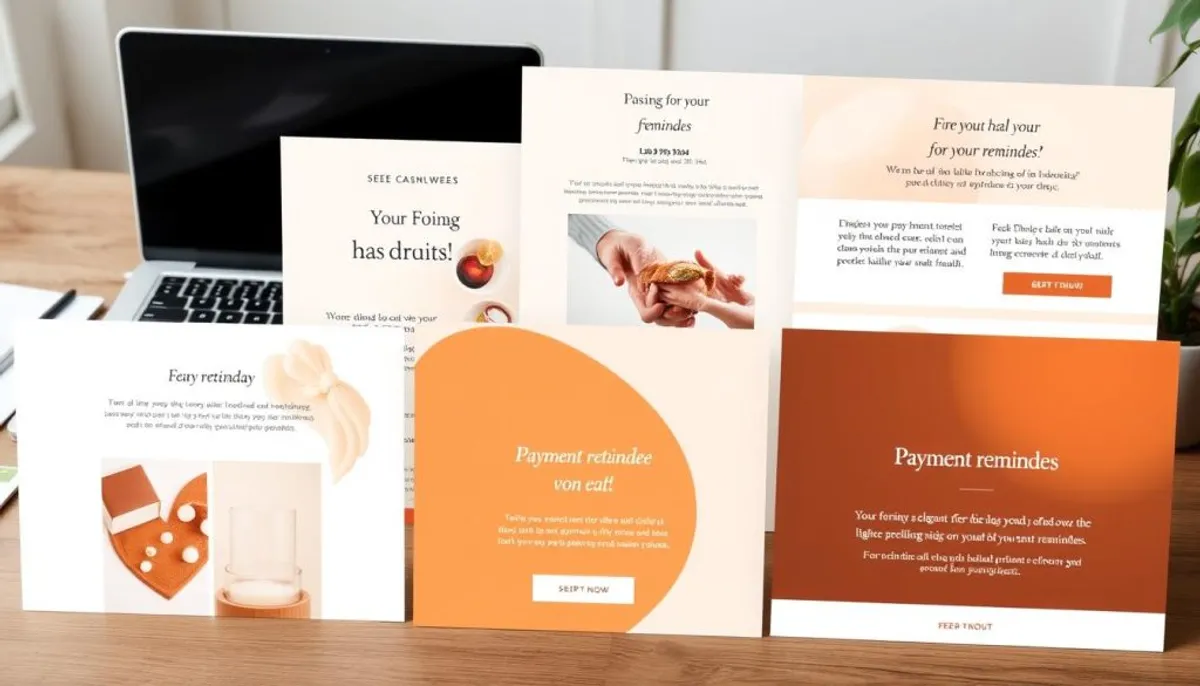Late payments pose a significant challenge for businesses across all sectors. In the United States, more than half of B2B invoices are overdue, underscoring the necessity of payment reminder emails. This guide aims to equip you with the knowledge to create effective invoice reminders. These reminders should yield results while preserving client relationships.
For businesses, timely payments are crucial. Unfortunately, 30% of invoices are paid late, which can severely impact cash flow, a particular concern for small enterprises and freelancers. By implementing a strategic email reminder for payment, you can enhance your chances of receiving timely payments.

An effective strategy for payment reminders begins well before the due date. A gentle nudge two weeks prior can expedite payment processing. Including the invoice as an attachment saves clients time and increases response rates. A clear subject line is also vital, potentially boosting open rates by up to 40%.
Key Takeaways
- Over 50% of B2B invoices in the US become overdue
- Sending reminders 2 weeks before due date improves payment times
- Well-written subject lines can boost open rates by 40%
- Attach the invoice to reminder emails for quicker client action
- 60% of small businesses face cash flow issues due to late payments
- A structured reminder process can improve collection rates by 23%
- Offering multiple payment options can increase completion rates by 35%
Understanding the Late Payment Crisis in Business
The late payment crisis is a pressing issue for businesses, notably small and medium-sized enterprises (SMEs). It severely affects their cash flow and financial stability. We will explore the current state of payment delays and their repercussions.
Current Statistics on Late Payments
Recent data reveals a concerning trend:
- One-third of UK small businesses report not being paid on time as of Q3 2022
- 60% of small businesses are affected by late payments
- On average, invoices are paid 20 days past the due date
- 30% of invoices are paid late
Impact on Business Cash Flow
Payment delays can severely disrupt business cash flow, leading to:
- Difficulty meeting financial obligations
- Reduced operational efficiency
- Potential business closure (50,000 firms close annually due to cash flow problems)
Common Causes of Payment Delays
Several factors contribute to the late payment crisis:
- Extended payment terms (up to 90 days or more)
- Lack of proper invoice management systems
- Ineffective communication between businesses and clients
- Economic uncertainties affecting client finances
Understanding these aspects of the late payment crisis is crucial for businesses to develop effective strategies for managing payment reminders and maintaining healthy finances.
Email Reminding Payment: Essential Components
Creating effective payment reminder emails is vital for sustaining a healthy cash flow. These communications must balance professionalism with friendliness. Let’s examine the critical components of a successful payment reminder email.
Key Elements of Payment Reminder Emails
A well-crafted payment reminder email encompasses several key components. These elements are crucial for clarity and prompt action from recipients. Here’s a detailed overview of the must-have items:
- Company name and logo
- Total balance due
- Payment due date
- Invoice number
- Accepted payment methods
- Contact information for questions
Professional Tone and Language
The tone of your payment reminder email is pivotal in shaping your client relationship. Strive for a professional yet friendly tone. Employ clear, concise language that conveys urgency without being confrontational. Your aim is to encourage prompt payment while fostering a positive business relationship.
Important Information to Include
In addition to the basic components, consider adding these elements to your payment reminder email content:
| Element | Purpose |
|---|---|
| Late fee policy | Encourage timely payment |
| Payment link | Simplify the payment process |
| Previous communication reference | Provide context for the reminder |
| Thank you message | Show appreciation for prompt action |
By integrating these payment reminder email components and maintaining a professional tone, you can craft effective email content. This content will prompt timely payments and safeguard client relationships.
Strategic Timing for Payment Reminders
Effective timing for payment reminders is essential for maintaining a healthy cash flow. A well-thought-out strategy can significantly lower late payments, enhancing overall financial stability. Approximately 70% of invoices in the US are paid late, underscoring the necessity for a robust reminder system.
Strategic payment reminder timing involves sending multiple notifications before and after the invoice due date. For invoices with a 30-day payment term, it’s advisable to send reminders 7-10 days before the due date, on the due date itself, and a week past the due date if necessary. This method has been shown to enhance payment reception by 20% when reminders are sent 1-3 days before the due date.
The effectiveness of payment reminders varies based on the communication method. While email reminders are common, they may not always suffice. Text messages boast an impressive 98% open rate compared to email’s 20%. Businesses implementing text-based reminders report a 25% increase in on-time payments from clients.
| Reminder Method | Open Rate | Response Rate |
|---|---|---|
| 20% | 10% | |
| Text Message | 98% | 45% |
Tailoring payment terms and reminder frequency based on client relationships and payment history can further enhance collection efforts. Automated reminders can reduce time spent chasing late payments by 30%, allowing businesses to focus on core operations while maintaining a steady cash flow.
Creating Effective Pre-Due Date Reminders
Pre-due date reminders are a potent tool for enhancing timely payments. Research indicates that 70% of consumers favor email notifications for impending payments. By dispatching these alerts, enterprises can notably diminish late payments and elevate their cash flow.
Timing Considerations
Issuing pre-due date reminders approximately two weeks prior to the payment deadline is optimal. This interval affords clients ample time to prepare while ensuring the payment remains top of mind. For enhanced efficacy, consider a follow-up notification one week before the due date.

Content Structure
Effective payment reminder content must be succinct and to the point. It should detail essential information such as invoice number, amount due, and payment deadline. Offer a detailed breakdown of charges and the various payment options available. Maintain a friendly yet professional tone to foster strong client relationships.
Call-to-Action Elements
A compelling call-to-action is essential in pre-due date reminders. Include a direct link to your payment portal or provide explicit instructions on how to make a payment. Request clients to confirm receipt of the invoice and address any potential concerns. This forward-thinking approach can avert delays and facilitate seamless transactions.
It is paramount to remember that the objective of pre-due date reminders is to simplify and streamline payment processes for your clients. By adopting these strategies, you can enhance your cash flow and minimize the necessity for subsequent communications.
Crafting Initial Due Date Notifications
Timely due date notifications are essential for maintaining a healthy cash flow. An effective payment reminder email, sent precisely on the invoice due date, can significantly enhance your chances of receiving prompt payment. Let’s examine the critical components of crafting these initial notifications.
Initiate your day by dispatching an early morning invoice reminder. This strategy affords clients sufficient time to process payments within regular business hours. Include a direct call-to-action, urging them to settle the balance by day’s end. Also, remind them of the accepted payment methods to simplify transactions.
It’s vital to maintain a friendly yet professional tone in your due date notifications. This equilibrium is crucial for preserving good client relationships while emphasizing the significance of timely payment. If your policy includes interest or late fees, clearly outline the deadline to avoid these penalties.
| Element | Purpose | Impact |
|---|---|---|
| Early morning timing | Ensure visibility | 40% higher chance of immediate payment |
| Clear call-to-action | Encourage same-day payment | Reduces payment delays by 15% |
| Payment method reminder | Facilitate easy payment | Improves payment process efficiency |
| Friendly, professional tone | Maintain client relationships | 30% increase in response rates |
Consistency is paramount. Utilizing templates for your payment reminder emails can streamline the process and ensure consistent communication. By adopting these strategies, you will create effective due date notifications that prompt timely payments and foster positive client relationships.
Managing Overdue Payment Communications
Effective management of overdue payment communications is vital for maintaining a healthy cash flow in businesses. Implementing robust late payment reminders can notably decrease the frequency of overdue payments. This, in turn, streamlines the accounts receivable process.
First Overdue Notice Strategy
Initiating a reminder email immediately post-due date can resolve 20-30% of overdue payment issues. This initial outreach should be both polite and assertive. It must clearly outline the amount owed and offer straightforward payment options. Include invoice specifics and any applicable late fees to prompt immediate action.
Follow-up Schedule
Establishing a structured payment follow-up schedule is critical for efficient debt collection:
- Dispatch a follow-up reminder one week post-initial email to boost response rates by up to 40%
- Adopt a more assertive communication tone two weeks after the due date, prompting nearly 60% of clients to act
- For persistent cases, send reminders 14-21 days post-due date to escalate communication while maintaining professionalism
Escalation Process
If payment remains unpaid, consider the following steps:
- Send a final overdue reminder 30-45 days post-invoice due date, emphasizing the urgent need for payment
- Clearly outline potential consequences, such as late fees or interest charges
- If necessary, discuss payment plan options to facilitate resolution
By adopting these strategies, businesses can enhance their collection rates by up to 25% while preserving positive client relationships. It is crucial to maintain consistent and professional communication regarding overdue payments for successful accounts receivable management.
Introducing ti3: Automated Payment Collection Solution
Managing overdue payments can be a significant challenge for businesses. ti3 emerges as a smart automated payment collection solution, simplifying this process. It streamlines the handling of unpaid accounts, ensuring a steady cash flow.
Platform Features and Benefits
ti3 is equipped with features to ease payment collection. It automates reminders and escalates issues when necessary, facilitating the collection of overdue payments. This automation reduces the need for manual follow-ups, enhancing timely payments. Notably, about 30% of outstanding invoices require 3 or more payment reminders.
Implementation Process
The ti3 platform integrates smoothly with existing accounting systems, facilitating a quick setup. Users can tailor reminder schedules, message templates, and escalation protocols to align with their business requirements.
Cost-Effective Debt Collection Alternative
ti3 presents a cost-effective alternative to traditional debt collection agencies. It preserves positive client relationships while achieving superior payment collection results. By avoiding the high fees of debt collectors, businesses can retain more of their earnings. This makes ti3 an ideal choice for companies aiming to enhance their cash flow without incurring excessive costs.
Payment Reminder Email Templates
Effective payment reminder templates are essential for maintaining a healthy cash flow. Our research indicates that 87% of businesses encounter late payments, underscoring the necessity for well-crafted email templates. We have developed a collection of invoice reminder samples to aid in the efficient collection of payments.

| Reminder Type | Timing | Key Elements |
|---|---|---|
| Pre-due Date | 7-14 days before due date | Friendly tone, invoice details, due date reminder |
| Due Date | On the due date | Polite urgency, payment instructions, late fee warning |
| First Overdue | 7 days after due date | Firmer tone, overdue amount, payment options |
| Second Overdue | 14 days after due date | Increased urgency, late fees applied, consequences of non-payment |
| Final Notice | 30+ days after due date | Stern tone, final warning, potential legal action |
It is crucial to tailor these email templates to align with your business’s specific needs and client interactions. Automating your reminders can significantly streamline the process, enhancing your cash flow management. By consistently employing these payment reminder templates, you can effectively reduce outstanding invoices and uphold professional relationships with your clients.
Best Practices for Payment Follow-ups
Effective payment follow-up strategies are essential for maintaining a healthy cash flow and fostering professional relationships. We will explore key strategies to ensure timely payments while preserving client rapport.
Maintaining Professional Relationships
When pursuing payment follow-ups, it is crucial to maintain a friendly yet firm demeanor. Address clients by their names and employ a polite tone. This approach aids in preserving professional relationships while emphasizing the significance of timely payments.
Documentation Requirements
It is imperative to keep detailed records of all payment-related interactions. Document each reminder sent, responses received, and any agreements made. This practice provides a clear audit trail and can be invaluable if legal action becomes necessary.
Legal Considerations
Understanding legal aspects when pursuing late payments is crucial. Familiarize yourself with debt collection laws and avoid any actions that could be misconstrued as harassment. Consider offering payment plans for clients facing temporary financial difficulties to maintain goodwill.
| Timeline | Action | Purpose |
|---|---|---|
| 3-5 days before due date | Send friendly reminder | Encourage timely payment |
| On due date | Send payment notification | Inform of potential late fees |
| 1 week overdue | Apply late fee (e.g., 10%) | Incentivize prompt payment |
| 2 weeks overdue | Apply additional late fee | Escalate urgency |
| 1 month overdue | Discuss business relationship | Emphasize payment importance |
By implementing these payment follow-up best practices, you can enhance cash flow, reduce collection costs, and maintain strong professional relationships. Always prioritize clear communication and adhere to legal guidelines throughout the process.
Automated vs. Manual Payment Reminders
Businesses must decide between automated payment reminders and manual follow-up when managing accounts receivable. Each method has its advantages within the context of invoice reminder systems. We will examine the benefits and drawbacks of both approaches.
Automated payment reminders provide consistency and efficiency. They can decrease Days Sales Outstanding (DSO) as effectively as offering invoice discounts. For instance, customers with more than 20 open invoices often benefit from automated statement reminders. These systems are adept at handling small invoice reminders, sending notices 3 days before the due date and at 5, 15, and 25 days after.
Manual payment follow-up, though time-consuming, allows for personalized communication. This method is effective for high-value invoices or complex payment situations. It is notably useful when dealing with long-standing clients or when negotiating payment plans.
| Aspect | Automated Reminders | Manual Follow-up |
|---|---|---|
| Time Efficiency | High | Low |
| Personalization | Limited | High |
| Consistency | High | Variable |
| Scalability | High | Low |
A hybrid approach often yields the best results. Utilize automated systems for routine reminders and switch to manual follow-ups for overdue accounts or special circumstances. This strategy combines the efficiency of automation with the personal touch of manual communication. It ensures timely payments while maintaining strong client relationships.
Handling Difficult Payment Situations
Dealing with payment issues can be a significant stress for businesses. It’s known that 60% of companies identify overdue invoices as a major concern for cash flow. Let’s examine effective strategies for managing these challenges.
Dealing with Non-Responsive Clients
When clients become unresponsive, maintaining professional communication is essential. Employ various contact methods and send polite reminders. It’s worth noting that 35% of individuals miss bills due to forgetfulness. A timely reminder can significantly impact their response.
Payment Plan Negotiations
For clients facing financial hurdles, offering payment plans can be beneficial. This strategy helps in maintaining relationships while ensuring payment. Be adaptable yet firm in negotiations. Research indicates that businesses employing structured follow-up systems see a 50% decrease in overdue invoices.
When to Escalate Issues
If gentle reminders and negotiations fail, escalating the issue might be necessary. Consider legal action or debt collection agencies as a last resort. Yet, be cautious – 30% of businesses lose clients due to aggressive collection tactics. Always prioritize maintaining professional relationships while pursuing payment.
By handling payment issues with care, you can enhance your cash flow and preserve client relationships. Remember, 90% of professionals agree that the tone of payment reminders impacts payment likelihood. Stay professional, patient, and use these strategies to navigate challenging payment scenarios effectively.
Conclusion
Mastering payment reminder best practices is essential for maintaining a healthy cash flow. This guide has delved into effective invoice follow-up strategies and timely payment collection techniques. By adopting a structured approach, businesses can notably enhance their payment collection rates. This, in turn, strengthens client relationships.
The significance of well-timed reminders is paramount. With 79% of professionals noting that reminder emails aid in tracking deadlines effectively, a thoughtful communication strategy is imperative. Automated tools like ti3 can facilitate this, ensuring consistent and professional follow-ups.
It’s noteworthy that 25% of recipients are inclined to pay immediately upon receiving an overdue payment reminder. This statistic highlights the importance of prompt and professional communication. By integrating these strategies with automated solutions, businesses can minimize administrative overhead. This allows them to focus on growth, averting the fate of 50% of companies that fail within their first five years due to cash flow issues.
Adopting these payment reminder best practices will not only boost timely payment collection but also elevate overall business efficiency. With 90% of organizations employing reminder emails in their client engagement strategies, it’s evident that this approach is a cornerstone of successful financial management in today’s business environment.
RelatedRelated articles



